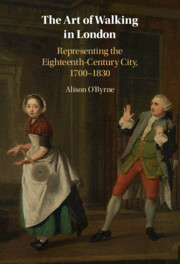Book contents
- The Art of Walking in London
- The Art of Walking in London
- Copyright page
- Dedication
- Contents
- Figures
- Acknowledgements
- Introduction
- Chapter 1 Mobility and Spectatorship in the Early Eighteenth-Century City
- Chapter 2 Promenading the Mall in St James’s Park
- Chapter 3 Imagining the Stranger
- Chapter 4 London Spied
- Chapter 5 Metropolitan Pleasures and Grievances
- Conclusion
- Bibliography
- Index
Chapter 5 - Metropolitan Pleasures and Grievances
Reimagining the Art of Walking the Streets of London
Published online by Cambridge University Press: 19 December 2024
- The Art of Walking in London
- The Art of Walking in London
- Copyright page
- Dedication
- Contents
- Figures
- Acknowledgements
- Introduction
- Chapter 1 Mobility and Spectatorship in the Early Eighteenth-Century City
- Chapter 2 Promenading the Mall in St James’s Park
- Chapter 3 Imagining the Stranger
- Chapter 4 London Spied
- Chapter 5 Metropolitan Pleasures and Grievances
- Conclusion
- Bibliography
- Index
Summary
Chapter 5 examines how early nineteenth-century accounts of walking in the city traced the nuisances and delights of urban living, helping to articulate a sense of collective experience that in turn shaped a sense of what it meant to be a Londoner. Many of these accounts of London emphasized the modernity of their moment by reimagining earlier eighteenth-century works, presenting them as inadequate to the task of describing the contemporary experience of the city. Trivia’s “art of walking the streets of London” was reworked to propose forms of selfish behaviour in the streets, and Pierce Egan’s Life in London broadly followed the template of spy guides while also showing his characters delighting in, rather than simply observing, all aspects of urban pleasure. Together, these works suggested new ways of thinking about moving through the streets of a city as crowded and busy as London.
Keywords
- Type
- Chapter
- Information
- The Art of Walking in LondonRepresenting the Eighteenth-Century City, 1700–1830, pp. 191 - 234Publisher: Cambridge University PressPrint publication year: 2025

